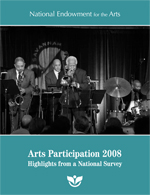CAA News Today
NEA Survey Shows a Decline in Art Participation
posted by Christopher Howard — Jun 16, 2009
 American audiences for the arts are getting older and their numbers are declining, according to new research released yesterday by the National Endowment for the Arts (NEA). Arts Participation 2008: Highlights from a National Survey, which can be ordered or downloaded from the NEA website, features top findings from the 2008 Survey of Public Participation in the Arts, the nation’s largest and most representative periodic study of adult participation in arts events and activities, conducted by the NEA in partnership with the US Census Bureau.
American audiences for the arts are getting older and their numbers are declining, according to new research released yesterday by the National Endowment for the Arts (NEA). Arts Participation 2008: Highlights from a National Survey, which can be ordered or downloaded from the NEA website, features top findings from the 2008 Survey of Public Participation in the Arts, the nation’s largest and most representative periodic study of adult participation in arts events and activities, conducted by the NEA in partnership with the US Census Bureau.
Five times since 1982, the survey has asked US adults eighteen and older about their patterns of arts participation over a twelve-month period. The 2008 survey reveals dwindling audiences for many art forms, but it also captures new data on internet use and other forms of arts participation. Although the 2008 recession likely affected survey responses, long-term trend analysis indicates that other factors also may have contributed to lower arts participation rates.
There are persistent patterns of decline in participation for most art forms. Although nearly 35 percent of US adults—an estimated 78 million—attended an art museum or an arts performance in the 2008 survey period, the figure is a decline from 40 percent reported in 1982, 1992, and 2002.
Attendance at the most popular types of arts events—such as art museums and craft or visual-arts festivals—saw notable declines. The US rate of attendance for art museums fell slightly from a high of 26 percent in 1992–2002 to 23 percent in 2008, comparable to the 1982 level.
Further, fewer adults are creating and performing art. Weaving and sewing remain popular as crafts, but the percentage of adults who do those activities has declined by 12 points. Only the number of adults doing photography has increased—from 12 percent in 1992 to 15 percent in 2008.
Historically the most dependable arts participants, forty-five to fifty-four-year-olds, showed the steepest declines in attendance for most art events, compared with other age groups. Educated Americans—the most likely to attend or participate in the arts—are doing so less than before, and less-educated adults have significantly reduced their already low levels of attendance.
In a positive trend, the internet and mass media are reaching substantial audiences for the arts. Consider these findings:
- About 70 percent of US adults went online for any purpose in 2008 survey, and of those adults, nearly 40 percent used the web to view, listen to, download, or post artworks or performances
- Thirty percent of internet-using adults download, watch, or listen to music, theater, or dance performances online at least once a week. More than 20 percent of them view paintings, sculpture, or photography at least once a week
- More Americans view or listen to broadcasts and recordings of arts events than attend them live (live theater being the sole exception). Classical and Latin or salsa music were the most popular music categories (with 40 and 33.5 million viewers/listeners, respectively), and 33.7 million adults reported listening to, or viewing programs or recordings about books and writers. The same number (33.7 million) enjoyed broadcasts or recordings about the visual arts.
The entire survey questionnaire, the raw data, and a user’s guide are available both on the NEA website and from Princeton University’s Cultural Policy and the Arts National Data Archive (CPANDA). More detailed study results will be available later this year.


